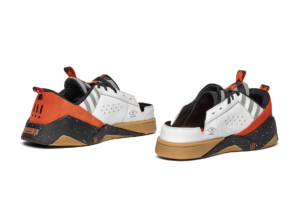

In the age of maximalist minimalism—where every accessory must strike a balance between ironic indulgence and aesthetic purity—GIVENCHY’s teddy bear in faux fur emerges not as a novelty, but as an emotional artifact shaped by couture discipline. This is not merely a luxury object; it is a totem of nostalgia filtered through the house’s creative modernism, a plush specter of softness reimagined under the razor-sharp vision of Matthew M. Williams.
A Creature of Couture
Plush toys have long danced along the borders of fashion and sentimentality, but the GIVENCHY teddy bear in faux fur marks a distinct evolution in that relationship. Crafted with the precision typical of the maison’s ateliers, the bear is swaddled in thick faux fur that simulates the rich tactility of mink, dyed in a deep noir that whispers to the gothic aesthetics frequently threaded through Williams’ work. It’s a couture statement masquerading as a plaything: anthropomorphic, adorable, and oddly ceremonial.
At just under a foot tall, the bear assumes the posture of something both huggable and haunting. Its jet-black pelt, sleek and dense, is more reminiscent of a rare evening coat than of anything born in a toy store. The GIVENCHY logo is embroidered not on its paw or ear as one might expect, but rather across its chest like a sigil—bold, declarative, and absolutely unapologetic.
Emotional Design in the Age of Post-Streetwear
Under Williams, GIVENCHY has consistently worked to reframe luxury through the lens of utilitarian drama and hyper-personal design language. The teddy bear, though non-functional in the traditional sense, aligns perfectly with this ethos. It is a piece of emotional design: a sculptural object meant not to perform a duty but to invoke a memory—childhood comfort, maternal warmth, the tactile pleasure of familiarity.
In many ways, it’s a counterpoint to the sharp tailoring and tactical textures of the brand’s RTW collections. Where a GIVENCHY technical jacket might bristle with utility and cold elegance, the teddy bear invites intimacy and softness. This juxtaposition forms a feedback loop in the label’s vocabulary: the harsh and the gentle, the structured and the amorphous, co-existing within the same aspirational ecosystem.
Indeed, the teddy bear could be considered an accessory only in the loosest sense of the word. It belongs less in a handbag than it does on a pedestal, not worn but worshipped. It channels the Maison’s recent fascination with the performative aspects of possession—what it means to own, to cradle, to exhibit.
The Rise of Plush as Prestige
The arrival of the GIVENCHY teddy bear is not occurring in a vacuum. Over the last decade, luxury houses have increasingly blurred the lines between childish affection and adult opulence. Think Louis Vuitton’s collaborations with Takashi Murakami or Yayoi Kusama’s surreal polka-dot figurines. Think Gucci’s “Zumi” dolls or Balenciaga’s oversized pillow bags. In that tradition, GIVENCHY’s bear fits comfortably within the lexicon of “wearable toys” and “collectible emotion.”
This bear, however, is not designed to be ironic. Its design is too pure, its execution too faithful to the animal form. There’s a sincerity to its presence that elevates it beyond kitsch. It’s an object steeped in sentiment, not sarcasm. And in a time when fashion often hides behind the shield of postmodern humor, that earnestness feels radical.
Retailing at an undisclosed but certainly premium price point, the bear is clearly aimed at the collector who treats luxury not just as apparel but as mythology. It is not about ownership—it is about stewardship. The GIVENCHY teddy is not to be worn or flaunted, but protected and admired like an heirloom or sculpture.
Material Ethics and Faux Fur Philosophy
One cannot discuss a faux fur teddy without acknowledging the material politics behind such a design. The use of faux fur—once considered the domain of budget-conscious imitators—is now a symbol of ethical evolution. GIVENCHY’s decision to use synthetic alternatives reflects not only broader industry trends, but a conscious alignment with the post-animal-testing era of luxury.
Yet, the faux fur here is not a secondary substitute—it is sumptuous, dense, and deliberately luxurious. In choosing to render the bear in black, the house underscores the intensity of the texture, allowing it to catch light in subtle waves. The touch is luscious. It whispers of glamour without cruelty, indulgence without blood. And this tension—between indulgence and ethics—is one that defines the new luxury customer.
GIVENCHY’s version of faux fur doesn’t imitate—it transforms. It doesn’t wish it were the real thing. It is the real thing: real, in the sense of authentic to a new generation’s values, real in its refusal to compromise on softness or silhouette.
From Runway to Repose: Object, Fetish, Companion
While the teddy bear has not graced the runway (yet), its presence looms large in the imaginations of the fashion elite. Editors, stylists, and collectors treat it as a familiar icon—less an object of fashion than an object of affection. Placed on coffee tables in Parisian apartments, photographed on minimalist pedestals, nestled among bespoke ceramics and art books, the bear is fast becoming a kind of fashion-world pet. Not something to style around—but to emotionally orbit.
This is not the first time plush has become fetish in fashion. Walter Van Beirendonck famously used stuffed animals as adornment in his surrealist collections. Supreme and Steiff collaborated on a streetwise bear in 2018. But this GIVENCHY iteration is more inward, more reserved. It speaks softly. It wears black. It has nothing to prove.
More than an ornament or a collectible, the GIVENCHY bear might be something more unexpected: a modern-day talisman. A charm to ward off the coldness of sleek minimalism. A guardian of sentimentality in a world addicted to surfaces.
The Future of Soft Power
Fashion has always been about the curation of desire. But desire is changing. Where once the consumer craved status, now they crave security. Where once exclusivity meant distance, now it means depth—of connection, of storytelling, of intention. The GIVENCHY faux fur teddy is an unlikely ambassador of this shift.
It represents a fusion of softness and seriousness. It reminds us that haute does not have to be loud to be resonant. That objects can still hold meaning beyond market value. That childhood, long dismissed as unchic, has a place within the cathedral of couture.
In this way, the bear is a silent revolution. It asks no questions, demands no spotlight. It simply exists, ready to be loved—and that, in today’s fashion landscape, might be the boldest gesture of all.
No comments yet.








